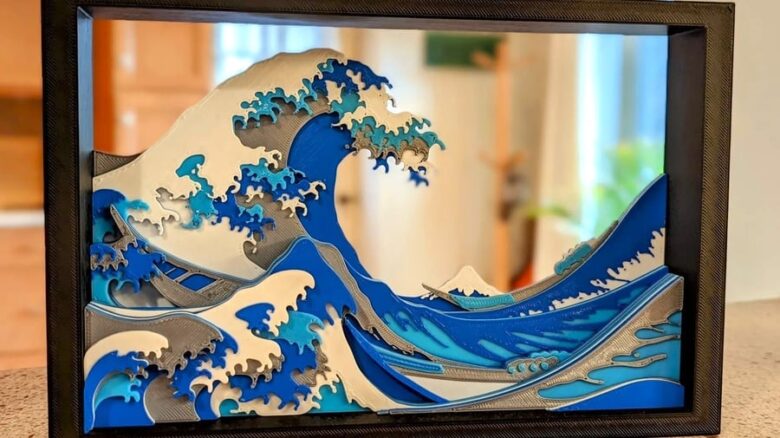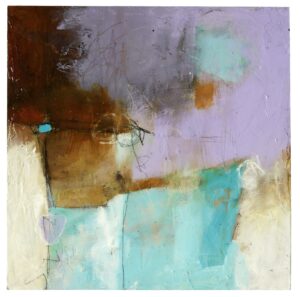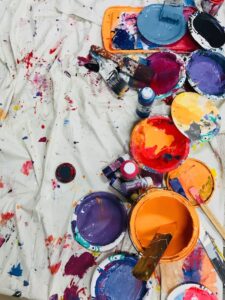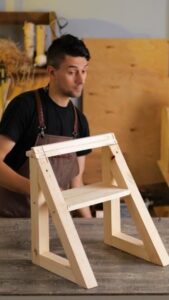Creating a masterpiece is no longer limited to traditional art forms. 3D printing technology gives artists a new canvas to explore – vibrant sculptures! This article dives into the world of 3D printing painting and finishing techniques. It shows the possibilities this innovative process offers.
3D printing works by depositing layers to create objects from materials like plastics, resins, and metals. But, the full potential of these creations is in the artistry of color application and finishing touches.
So, unleash your creativity with various painting techniques. Airbrushing or brush strokes? Acrylic paints offer versatility and durability, while oil-based paints add depth with their lustrous finish. Mix digital precision with traditional techniques.
Take sculpting endeavors further with advanced finishing techniques. Use sanding to refine rough surfaces and prepare them for finer details or textures. Apply sealants or varnishes to preserve colors and get a professional touch. Try different finishes like gloss or matte for a desired visual impact.
Patience is vital throughout this artistic process. Let each layer of paint dry thoroughly before proceeding. This prevents smudging or unwanted smears.
Pro Tip: When experimenting with 3D printing painting and finishing techniques, practice makes perfect. Embrace trial and error, and seek inspiration from other artists.
3D printing opens a new dimension of sculpting possibilities. Use the precision of technology with the artistry of painting and finishing to bring creations to life. So, grab your digital brushes and embark on a captivating journey of sculpting with colors in the realm of 3D printing.
Understanding 3D Printing Painting and Finishing Techniques
To better understand 3D printing painting and finishing techniques, dive into the world of sculpting with color. Explore the significance of mastering painting techniques in 3D printing and discover the artistry behind this process. Uncover the essence of 3D printing painting and understand its importance within the realm of creativity.
What is 3D printing painting?
3D printing painting is adding color and texture to 3D printed objects. It’s used to create a desired visual effect. Airbrushing is one popular technique, which offers precise control over the paint application. It also creates gradients and shading to make the object look realistic. Hand painting is also an option, offering detailed customization with different colors and brush strokes. Before painting, it’s important to prepare the surface with sanding and priming.
A great example of 3D printing painting is a collaboration between artists and medical researchers. They used 3D printing to make lifelike models of human organs. The artists then painted these models with accurate textures and colors. The result was an immersive learning experience for medical students, who could study the intricately painted models up close.
Why is it important to master painting techniques in 3D printing?
Painting techniques are key to 3D printing; they add the finishing touch and elevate quality and look. Mastering these techniques unlocks customization and creativity, enabling individuals to make one-of-a-kind 3D prints.
Understanding painting techniques in 3D printing can open a world of opportunities. Learning how to paint and finish 3D prints can change a plain object into a work of art. It can create interesting patterns, realistic textures, and mix colors to enhance visuals.
Mastering painting techniques is also important for achieving a professional end result. Applying high-quality finishes can affect the perception of the final product. A well-painted 3D print shows attention to detail and craftsmanship.
To reach mastery, consider these tips:
| Tip | Description |
|---|---|
| 1. | Proper surface preparation: Before painting, clean and smooth the surface. Sanding down imperfections and applying primer will build a base for the paint. |
| 2. | Select proper paints: Not all paints are suitable for 3D prints. Acrylic paints are often used since they stick to materials used in 3D printing. Spray paints can provide smoother finishes than brush application. |
| 3. | Layering techniques: Trying different layering techniques can add dimension to the finished print. Dry brushing or sponging can create unique textures and effects. |
| 4. | Seal the paint: To protect from wear and tear, apply a clear coat or varnish. This not only shields the painted layers but also makes the object more durable. |
By following these hints and refining painting techniques, exceptional results in 3D printing can be achieved. The mastery of painting techniques can not only boost visuals, but also allows for more artistry and personalization. So, grab your brush and explore the world of 3D printing painting!
Choosing the Right Materials and Tools
To achieve optimal results in sculpting with color, it’s crucial to choose the right materials and tools. In this section, we’ll guide you through selecting the best paints for 3D prints and provide insights into the essential tools and brushes for painting on 3D printed models.
Selecting the best paints for 3D prints
When it comes to picking paints for 3D prints, there are a few elements to consider. The filament, the desired finish, and the purpose of the print all make a difference. To help you make an educated choice, here are some of the most popular paints:
| Type | Benefits |
|---|---|
| Acrylic Paint | Water-based, easy to brush/airbrush, quick drying, and plenty of colors |
| Enamel Paint | Durable, glossy finish, airbrush/hand-paint, but needs more drying time |
| Spray Paint | Quick, easy to cover big areas, but not as precise as other methods |
| Lacquer Paint | High-gloss finish, fast drying, airbrush/brush, but has harsh chemicals |
Mixing colors and experimenting with techniques can lead to amazing results! Quality is also important. Low-grade paints and adhesives can damage the print over time. So make sure to reach for the best materials to get both a great look and durability. Happy painting!
Tools and brushes for painting on 3D printed models
Painting on 3D printed models? It requires special materials. Let’s explore what you need:
- Brushes of various sizes and shapes.
- A miniature airbrush for tiny details.
- Sponges and stippling brushes for texture.
- Masking tape to cover certain parts.
- A sharp hobby knife for adjustments.
- A palette or palette paper for mixing colors.
Remember to clean your brush properly after each use. And don’t forget, practice makes perfect. Take your time!
Ah, one more thing – “dry brushing”. This technique removes most of the paint before lightly brushing the raised surfaces. Highlighting and depth are achieved!
Preparing and Priming the 3D Print
To ensure a flawless finishing for your 3D prints, prepare and prime them using the right techniques. Clean the print, fill gaps and sand the model, and apply a primer. These sub-sections will guide you through the process, resulting in a smooth and professional surface for your painted 3D prints.
Cleaning the print
- Gently brush the print with a soft-bristle brush. This’ll help remove any loose particles or debris.
- Next, rinse with lukewarm water. Don’t use too much force.
- If there’s stubborn residue, put it in a container filled with isopropyl alcohol or acetone. Shake it gently as it soaks for a few minutes.
- Put the print on a clean towel or rack to air dry. Don’t use paper towels; they leave lint or fiber particles.
- Inspect the print for any remaining imperfections or areas that need more cleaning. Tweezers help if necessary.
- To get a polished finish, use sandpaper or fine-grit files. Go slowly and methodically.
- When handling solvents or sharp tools, wear gloves and protective eyewear.
Filling gaps and sanding the model
- Fill any gaps or imperfections on the model with filler material. Use a spatula or putty knife to spread it evenly.
- Allow the filler to dry before sanding. This will help level the gaps.
- Start sanding with fine-grit sandpaper. Do gentle strokes, then increase pressure as needed. Smooth out rough areas and remove excess filler.
- Switch to finer sandpaper for a polished finish. Sand until the surface feels smooth.
- Using different fillers can provide various results in terms of adhesion. Experiment to find the best fit for your 3D print project.
- During the Renaissance, sculptors had trouble with cracks in their marble after carving. So they mixed powdered marble with natural glue from rabbit skins or fish bladder extract, applied it, then sanded it down. This resulted in repaired sculptures that were both structurally sound and aesthetically pleasing.
Applying a primer
When 3D printing, primer application is essential. It helps ensure that the 3D print and the final coating will stick together. It also creates a smooth finish.
- Pick a primer suitable for your material – plastic, metal or wood.
- Clean the surface to get rid of dirt, dust and oil.
- Use a brush or spray gun to evenly apply the primer.
- Dry the primer as per instructions.
- Sand if needed for a smoother finish.
- Be precise when applying the primer.
Remember to follow the guidelines that experts and manufacturers recommend. Primer use not only increases adhesion but also covers up small imperfections, creating a great end product.
Painting Techniques for 3D Prints
To achieve vibrant and eye-catching 3D prints, master the art of painting techniques. Start with base coat techniques to establish a solid foundation. Then, explore layering and blending colors for a smooth and seamless finish. Finally, discover how to add texture and effects for added visual interest.
Base coat techniques
Achieve an amazing finish on your 3D prints! Mastering the base coat techniques is key. Let’s explore how to enhance the appearance of your 3D prints. Here’s a guide:
| Preparation |
|---|
| 1. Get rid of dust & debris using a brush or air. |
| 2. Sand down rough areas. |
| 3. Wipe with alcohol – get rid of oils & grease. |
| Priming |
| 1. Get a quality primer specifically for 3D prints. |
| 2. Follow manufacturer instructions for applying. |
| 3. Spray-on or brush-on work well – depending on size. |
| Layering |
| 1. Start with thin coats of chosen base color. |
| 2. Allow layers to dry before applying more. |
| 3. Masking tape or stencils can create patterns & separate colors. |
Consider material & intended use when selecting techniques. For example, sanding the surface after priming can improve adhesion for ABS filament. To further enhance results:
- Use an airbrush for precise control & smooth finish.
- Mix & match colors for unique effects.
- Add texture (e.g. dry brushing) for extra interest.
Follow these suggestions & achieve professional-looking base coats! Take your time, practice & experiment to get the best results.
Layering and blending colors
Successfully layer and blend colors with just 5 steps!
- Pick a base color. Can be neutral or any color you choose.
- Add layers of paint in different shades. Use a brush or sponge to blend the colors together.
- Vary opacity. Create depth and highlights with opaque and translucent colors.
- Use dry brushing. Apply paint to raised surfaces and edges for texture.
- Seal your print. Use a clear sealant or varnish.
Remember that experimentation is key. Different techniques can give unique results. Amazingly, some artists use airbrushing for gradients and smooth color transitions on prints!
Adding texture and effects
Enhance the look of your 3D prints with texture and effects. Create unique and eye-catching designs that stand out! Here are some ways to do it:
- Embossing: Add raised or recessed patterns on the surface for a tactile quality and depth.
- Painting: Apply paint for color, gradients, shading, and highlights.
- Airbrushing: Use an airbrush for precise control over paint and realistic textures.
- Surface treatments: Sand, polish, or apply coatings to further enhance texture.
- Mix materials: Combine different materials for contrasting textures.
For successful texture and effects, try these tips:
- Dry brushing or stippling to create textures.
- Choose embossing patterns that match your print.
- Use high-quality paints and primers made for 3D prints.
- Research finishing techniques for rust, wood grain, etc.
- Test material combinations for dynamic visuals.
Bring your 3D prints to life with texture and effects. Explore your creativity and make each print a masterpiece!
Finishing Touches
To add the perfect final touches to your 3D printed creations, turn to “Finishing Touches” in our article on “Sculpting with Color: 3D Printing Painting and Finishing Techniques.” Discover how sealing the paint job and adding a glossy or matte finish can elevate the visual appeal and durability of your prints. Say goodbye to incomplete projects and hello to professional-quality finishes.
Sealing the paint job
When it comes to sealing the paint job, detail is paramount. Don’t let your hard work go in vain – just follow these 6 steps:
- Choose the perfect sealant for your project. Think about factors like sturdiness, weather-resistance, and finish.
- Clean the surface and make repairs. This will help the sealant stick.
- Apply the sealant in thin coats. Don’t use too much – this can lead to drips and uneven drying.
- Let each coat dry completely before applying the next. This prevents smudging or streaking.
- Sand lightly between coats if needed for a smooth finish.
- Inspect the paint job for any flaws. Fix any areas that need further sealing or attention.
Additionally, different types of paint may require different sealants. For example, oil-based paints may need an oil-based sealer, and water-based paints may need a water-based sealer. Be sure to read the manufacturer’s instructions for best results.
Sealing is a must-do for a lasting paint job. The right sealant defends your work from wear and tear, keeping it beautiful for years.
Don’t miss out on a professional finish – seal with confidence today!
Adding a glossy or matte finish
A glossy and matte finish have differences in their looks and texture. A glossy finish is smooth and shiny, while a matte finish is soft and velvety. These finishes can be used to enhance many materials, such as wood, metal, paper, and photographs. With glossy finishes, one can expect colors to appear vibrant. Matte finishes, however, provide a subtle elegance and reduce reflections.
The concept of these finishes dates back to the Renaissance period. Back then, high-quality reflective varnishes were used for paintings. Glossy finishes were utilized to give them depth and luminosity. Northern Renaissance painters, on the other hand, chose matte finishes to achieve a velvet-like texture.
Today, glossy and matte finishes remain vital in design aesthetics. So for your next project, take into account which finish best suits your desired effect. Every decision has its roots in history.
Conclusion
Our exploration of 3D printing painting and finishing is complete. We now have access to a plethora of creative possibilities. An array of colors and techniques can take our models to the next level.
We have examined the intricate process of painting and finishing 3D prints. We know the types of paint and how to use them. We have gained knowledge of sanding and priming.
One unique technique is airbrushing. This tool is great for capturing smooth gradients and intricate details. The controlled application of paint creates a professional finish.
Post-processing is important. Sanding and priming give our final product a flawless look.
Experimenting with finishes is also crucial. A glossy or matte coating can protect our artwork and add depth. It can totally alter the appearance of our prints.
Frequently Asked Questions
FAQs: Sculpting with Color: 3D Printing Painting and Finishing Techniques
Q1: What types of 3D printing painting techniques can be used for sculpting with color?
A1: There are various techniques for adding color to 3D printed sculptures. Some popular methods include airbrushing, hand painting, and using UV-sensitive or thermochromic materials.
Q2: Is it necessary to post-process a 3D print before painting?
A2: Yes, post-processing ensures the surface of the 3D print is smooth and free from imperfections. Common post-processing techniques include sanding, priming, and applying a base coat to enhance paint adherence.
Q3: Can any type of paint be used for 3D printed sculptures?
A3: Not all paints are suitable for 3D printed sculptures. Acrylic paints are commonly used due to their versatility and ability to adhere to a variety of materials. It’s important to choose paints specifically formulated for the intended surface.
Q4: How can realistic textures and effects be achieved in 3D printed sculptures?
A4: Realistic textures and effects can be achieved through techniques like dry brushing, stippling, and washes. These methods help add depth, highlights, and shadows, creating a more lifelike appearance.
Q5: Are there any specialized tools required for painting 3D printed sculptures?
A5: While basic painting supplies like brushes and palettes are necessary, there are additional tools that can aid in the painting process. These may include airbrushes, masking tape, sculpting tools for touch-ups, and magnifying glasses for finer details.
Q6: How can I protect and seal the paintwork on a finished 3D printed sculpture?
A6: To protect the paintwork, a clear coat or varnish can be applied. This not only provides a layer of protection against scratches and fading but can also enhance the overall appearance of the sculpture.



